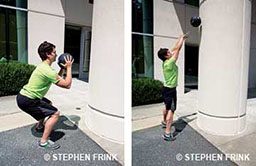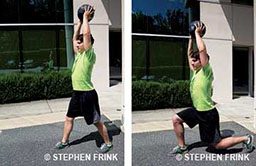High-intensity interval training (HIIT) and extreme conditioning programs have steadily grown in popularity. This approach to fitness was previously used only in the military and competitive sports but has now gained the attention of the general active population. The methodology focuses on maximizing physiological adaptions through high-intensity exercises. Like scuba diving, exercise training (especially HIIT) requires proper preparation and instruction to ensure a safe and positive experience.
Circuit-training programs typically combine bouts of high-intensity exercise with reduced-effort rest intervals. The interval lengths vary based on ability and training goals. The high intensity of the exercises targets the muscles, while the short recovery periods target the cardiovascular system. Both muscular strength and cardiovascular fitness are important components of fitness for scuba divers.
HIIT is for everyone, regardless of current training state. “High intensity” is based on the individual’s perceived level of exertion. The work/rest intervals are variable and should be adjusted based on personal fitness.
The primary benefit of this type of training is maximal results in minimum time. Thus it can overcome the predominant excuse for not exercising regularly: lack of time. Effectiveness is due to the physically and metabolically demanding nature of these programs. The FITT principles — frequency (how often one exercises), intensity (percentage of maximum effort), type (particular exercises performed) and time (length of training sessions) — must be increased gradually to maximize fitness benefits while minimizing the risk of injury. In fitness circles this is commonly referred to as progressive overload.
Always be mindful of how your body feels. The old adage “no pain, no gain” is a fallacy. Pain is the nervous system’s mechanism for alerting the body there is problem. Fighting through pain may lead to injury and extended time away from exercise and diving. If it hurts or if you break form due to fatigue, rest before continuing. HIIT is a challenging training method with a focus on maximal effort, but safety and proper form are the foundations of any exercise program and must always remain a priority.
Regular variation of exercises prevents your body from plateauing while targeting a variety of muscles in a dynamic manner. Feel free to integrate some of your favorite full-body functional movements into the workout. The intensity will vary based on your personal motivation, training state and fitness goals. It is vital that you stay within your “safe zone” — if it hurts, stop and regroup before continuing.
First, determine if you are going to do the workout based on time, repetitions or repetitions for time.
Time: A common interval is 1:1 (e.g., 60 seconds of work followed by 60 seconds of recovery). If you are new to HIIT training, you may want to start with a 1:2 interval (30 seconds of work followed by 60 seconds of rest) and gradually reduce the rest time.
Repetitions: Commonly used repetitions are 8, 10, 12 or 15. Determine how many repetitions you will complete with good form prior to moving to the next exercise.
Repetitions for Time: Set a work/recovery time interval (e.g., 1:1), and see how many repetitions you can complete using proper form. This establishes a goal for you to beat in successive workouts.
Try to complete between four and eight rounds of the following exercises.
Wall Ball

- Stand upright facing a wall and holding a medicine ball just above chest level.
- Sit back into squatting position. The depth of squat will vary by individual, but the ultimate goal is to get your hips slightly below knee level. Knee pain is an indication to stop the exercise and revisit the basic squatting technique.
- Drive up, fully extending both legs and throwing the medicine ball at a specific spot on the wall.
- Catch the medicine ball, and return to squatting position.
- Repeat.
T Push-Ups

- Start in plank position.
- Complete a push-up (go as low as you feel comfortable; at first you may only be able to bend your elbows a little).
- Raise your right arm to the side while rotating your body. Look up your arm to the ceiling.
- Slowly lower your right arm back to the floor while rotating your body back into plank position.
- Do another push-up.
- Rotate your body again, raising the left arm this time.
- Repeat.
Tips: When raising your arm (step 3), make sure the motion is slow and controlled. If you cannot do a complete push-up, just bend your elbows slightly; as your training progresses, you will be able to complete full push-ups.
Overhead Lunges

- Begin by standing upright with a medicine ball extended overhead.
- Step forward with one foot while maintaining an upright position.
- Slowly drop your back knee toward the floor while holding the medicine ball overhead.
- Push up and back off the front foot just before the rear knee touches the floor.
- To avoid unduly stressing the knee, make sure the front knee does not extend past the front toe.
- Return to starting position.
- Repeat, leading with the opposite foot.

Tips: Be sure to maintain an upright position. Do not let your knee touch the floor.
Elbow to Knee
- Start on your hands and knees with a flat back.
- Extend your right arm and left leg, elongating your body.
- Crunch your right elbow to your left knee.
- Place your right hand and left knee back onto the floor.
- Repeat with your left hand and right knee.
© Alert Diver — Q3 Summer 2013